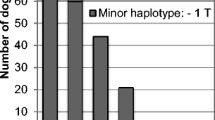Abstract
Amplification of mtDNA D-loop fragments with a length of 200 bp or more from ancient and even from fairly recent biological samples, can lead to erroneous results. This was clearly illustrated in our investigation of the putative heart of Louis XVII. By selecting different sets of primers which amplified shorter fragments of mtDNA (length 109 bp–201 bp), authentic polymorphisms could be visualised which remained undetected with the more classical primers for fragment sizes > 210 bp. Here we have extended those findings to other biological materials. A competitive PCR assay for quantitation of the amount of mtDNA for different fragment lengths, using a 10 bp deletion construct, was applied to ancient material and on a set of hairs of various ages of sampling (1966 up to the present). The results showed that DNA degradation started a few years after sampling. In the DNA extracts of the older hair shafts (1983–1995), the proportion of the number of short fragments to the number of long fragments is on average 4 in contrast to the most recent hair shafts. The numbers of amplifiable mtDNA copies for the hairs from 1975 and older were too small to show a clear difference. Use of long PCR fragments in such cases can yield misleading results. Use of short PCR fragments for the analysis of mtDNA from shed hair, in combination with a competitive PCR assay to determine the state of degradation, should improve the reliability of forensic mtDNA analysis considerably.
Similar content being viewed by others
Author information
Authors and Affiliations
Additional information
Received: 2 November 2000 / Accepted: 23 February 2001
Rights and permissions
About this article
Cite this article
Jehaes, E., Toprak, K., Vanderheyden, N. et al. Pitfalls in the analysis of mitochondrial DNA from ancient specimens and the consequences for forensic DNA analysis: the historical case of the putative heart of Louis XVII. Int J Leg Med 115, 135–141 (2001). https://doi.org/10.1007/s004140100221
Issue Date:
DOI: https://doi.org/10.1007/s004140100221




